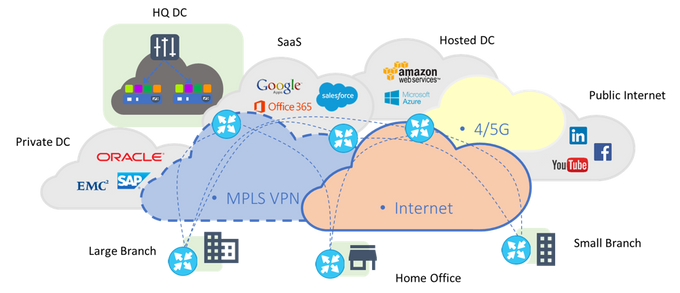How Dramatic Reduction in the Cost of Routing Will Change Your IP Network Architecture
Network architects must start planning today to push routing intelligence— which provides application performance guarantees and security controls—to the very edge of their networks.
Updated May 10, 2024

The decoupling of HW & SW and the adoption of open source is changing networking monopolies.
Compute and storage have undergone tremendous changes in both preferred methods of delivery and price. Surprisingly, network routing technology has not fundamentally changed in the past 20 years and remains inherently complex and expensive.
This will change as routing innovation moves to software and no longer depends on proprietary hardware. Marketplace competition is increasing, and we could see the demise of the Cisco monopoly as open source options become mainstream.
Network architectures are consistently evolving because the fundamental principles of how you design networks change over time. Unlike physics and chemistry, which have natural laws that do not change, the underlying technology and business models for networking change every 10-15 years.
We are undergoing another major industry transition as the underlying switching and routing technology moves to software. Large cloud providers such as Amazon, Facebook, and Google have jumped on this early and have IP networks that are 100x faster at a fraction of the cost of traditional large enterprises or Network Service Providers.
The Impact of Changes in Networking
While much has been written on how Software Defined Networks (SDNs) will transform networking, most in the industry underestimate the magnitude of its impact. Routing in software is part of the SDN story and will allow for the following:
Commoditization of Routing Software
Software-based business models that support freemium and open source, reducing costs by up to 95%. Cisco and the legacy network vendors are just starting to feel this impact. The world's leading cloud companies are using less legacy vendor networking gear, and this trend is moving over to NSPs and enterprises. This trend will accelerate.
Routing Everywhere
Instead of a network architecture based on edge, distribution, and core layers, where routing and security are expensive and done in the distribution layer, routing can be pushed to the very edges of the network, and the distribution layer can be done away with. This flatter network architecture allows for the following:
- Routing In clients: The end client can use multiple networks concurrently and securely. For instance, instead of your cell phone talking on one Wifi or 4/5G network at a time, the ability to use multiple networks concurrently to improve performance, provide seamless roaming, and optimize costs. Doing away with static VPN clients and moving to dynamic session management.
- Routing in containers: Applications have the ability to automatically, in real-time, get the network resources required for an application session. With the help of things like Named Data Networking (NDN), applications will be able to integrate with network controllers and use words to define routing and security policies instead of IP addresses composed of numbers.
- Dynamic mesh architecture: Instead of a hub and spoke architecture, users and applications can talk directly to each other. The problem with today's SDNs is that they rely on overlays and tunnels, which form a hub and spoke architecture. In a world where users and applications are mobile, the optimal network route is constantly changing.
Zero Trust Security
Creating a "Deny by Default" network architecture where packets are not allowed onto the network unless there is an explicit policy to do so. The security model today of using borders and network address translation fragments networks and does not deliver the level of security required going forward.
Switching Moving to the Edge
While Ethernet switching is used at the edge and core of networks because it is fast, simple, and cheap; the performance, security, control, and reporting of routing is better. When routing software resets its pricing levels and runs on the user's device and within applications, then networks can be just another service that can be automatically called upon through Application Programmable Interfaces (APIs).
The large cloud providers are currently over-building their networks using commodity Ethernet switches. While this architecture works well within their respective domains of data centers and data center interconnects, it does not provide end-to-end performance and security to other cloud providers and end users, where there are bandwidth constraints and security risks.
This is why up-and-coming cloud providers are also starting to provide networking into the enterprise with their cloud services so that they can guarantee the quality of experience and security to the end users.
Closing Notes
Network architects must start planning today to push routing intelligence that provides application performance guarantees and security controls to the very edge of their networks.








